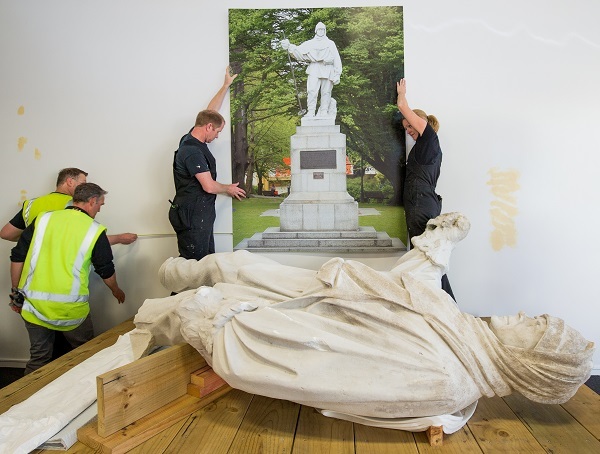The battered and broken statue of Captain Robert Falcon Scott has been installed in the foyer of Canterbury Museum’s special exhibition, Quake City, while heritage experts plan its restoration.

The 3-tonne, 2.6 metre high, white marble statue of Scott in polar dress had stood on the corner of Worcester Street and Oxford Terrace since 1917, but was thrown off its plinth and fractured in two during the 22 February 2011 earthquake.
Museum Director, Anthony Wright says the Museum is grateful to Christchurch City Council for agreeing to place the statue on temporary display at Quake City. While there is an admission charge for Quake City, the statue is being placed in the foyer so that everyone can see it.
“The Scott statue has been an important part of the Christchurch streetscape for almost a century and is a very tangible reminder of the region’s links with the Antarctic and the heroic age of exploration and discovery of the great white southern continent,” says Mr Wright.
Scott was one of three statues thrown off their plinths in the earthquakes. The Council reinstated the statue of John Robert Godley in Cathedral Square in February last year and hopes to return William Rolleston to its plinth outside Canterbury Museum in the near future.
Christchurch City Council Head of Parks Andrew Rutledge says the Council has received many enquiries about when the statue might be reinstated.
"The Scott statue was very badly damaged in the quakes and heritage experts will be assessing a repair strategy over the coming months. In the meantime, we are pleased he can return to public view at Quake City."
The statue of Scott was commissioned by the Council in 1913 and sculpted by Scott’s widow Kathleen, who was an accomplished sculptor. Kathleen first visited Christchurch to farewell her husband when the Terra Nova expedition sailed from Lyttelton in November 1910. She was travelling back to the city to be reunited with him when she learned the polar party had died nearly a year earlier on their return journey from the South Pole.


